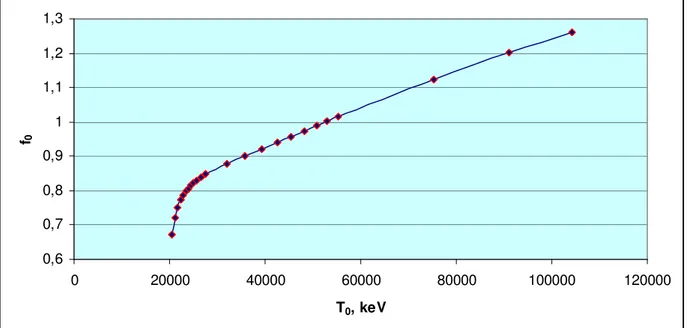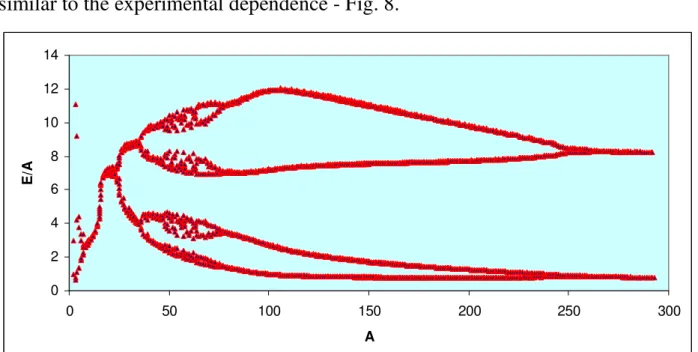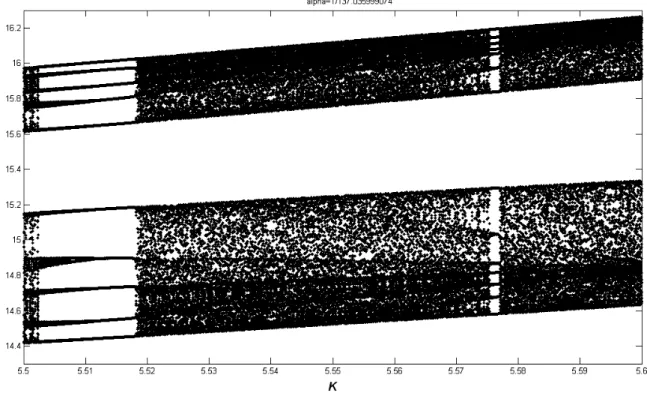УДК 531.9+539.12.01 UDC 531.9+539.12.01
БИФУРКАЦИЯЭНЕРГИИСВЯЗИИХАОСВ АТОМНЫХЯДРАХ
BINDING ENERGY BIFURCATION AND CHAOS IN ATOMIC NUCLEI
Трунев Александр Петрович к.ф.-м.н., Ph.D.
Alexander Trunev
Cand.Phys.-Math.Sci., Ph.D.
Директор, A&E Trounev IT Consulting, Торонто, Канада
Director, A&E Trounev IT Consulting, Toronto, Canada
В работе рассмотрена модель хаотического
поведения нуклонов в атомных ядрах, построенная на основе модели ядерных взаимодействий и статистики Ферми-Дирака
The model of chaotic behavior of nucleons in nuclei, based on the model of nuclear interactions and the Fermi-Dirac statistics is discussed
Ключевые слова: НЕЙТРОН, ПРОТОН, ФЕРМИ-ДИРАКА СТАТИСТИКА, ХАОС, ЭНЕРГИЯ СВЯЗИ, ЯДРО
Keywords: BINDING ENERGY, CHAOS, FERMI-DIRAC STATISTICS, PROTON, NEUTRON, NUCLEI
It is known, that the binding energy of nucleons in atomic nuclei depends
on a regular motion of protons and neutrons in the nuclear shells, and on the
chaotic behaviour of nucleons, which correlates with uncertainty in the
measurement of the mass of the nuclides [1-3]. The concept of quantum chaos
[4-5] is the basic model of chaotic behaviour of the nucleons.
We consider the model of the bifurcation of the binding energy in atomic
nuclei, based on the generalized dynamics of the Verhulst-Ricker-Planck
equation [6]. To derive the equations of the model the results of the theory of
strong interactions of nucleons in nuclei [7-8] used. According to this theory
there is a relationship between the size of the nucleus, binding energy and the
interaction parameter, which can be written as follows:
rnE = SbnlA = β (A)A (1)
Here, A = N + Z - the number of nucleons (protons + neutrons), as the
units used the speed of light, Planck constant and electron mass. The binding
energy is determined by the number of nucleons with a total mass of proton and
electron, thus E = A(mp /me +1) − M A / me .
Since equation (1) must be shared with the standard expression of the size
of the nucleus, r(A) = r0A1/3, reflecting the weak compressibility of nuclear
[9]. As a result, we find the product of the binding energy and nuclei radius
depending on the number of nucleons - Fig. 1. For consistency with the data [9],
we put
A A) 0.05325 ln
( = β . 0 10 20 30 40 50 60 70 80 90 100
0 50 100 150 200 250 300
A
rE
Data [9]
Eq. (1)
Fig. 1: The product of the binding energy and nuclei radius depending on
the number of nucleons according to [9].
Using this correlation, we can represent equation (1) as
EA = βA / rA (2)
Now we can construct a discrete model of the energy levels in nuclei as
follows: 2 1 3 2 1 2 2 1 ) ) ( )( 1 )( 1 ( 3 4 3 / 4 ) ) ( )( 1 )( 1 ( A A A A Ar r r A r r A A A A E E A A A A A A A β β π π β β + + = + + = + + + (3)
On the other hand, the density of nucleons can be related to the binding
1 / 1 / 3 /
4 3 = ( )/ + + ( )/ +
= −µ θ −µ θ
π Z Z EN N
N E Z A A e A N g e A Z g r A
n (4)
Here gi,Ei,µi,θ are the weight factors, energy and chemical potential
of protons and neutrons, and the statistical temperature of the nucleon,
respectively. Model (3) - (4) was investigated in a wide range of parameters. Let
us consider the results obtained in the simplified model under the condition of
equality of chemical potentials and energy of the two types of nucleons
A E E
EZ N A
A Z
N = µ = µ = θ ln α, = = − /
µ .
In this case, the model can be written as
A A g g g g A K A E x e A A A K x x Z N A A A A x A A A ln 05325 . 0 ) ( ; 3 4 , ) 1 ( ) ( ) / 1 1 ( 3 0 2 3 / 2 0 2 1 = + = = = + + + = − + β α θ π θ α β β (5)
To close the model (5), it is necessary to formulate the law of temperature
and the weight factor change with the number of nucleons. We use a simple
hypothesis, which follows from the theory of the Fermi gas of elementary
particles [10] that these parameters are proportional to the cube of the boundary
momentum, which in turn is determined by the size of the system:
A
A k p p k r
g p
k1 03, = 2 03, 02 = 3 / =
θ (6)
Hence, we find that the temperature and the weight factor decreases with
increasing number of nucleons as follows
1/2
0 2 / 1 0 , − − =
= T A gA g A
θ (7)
Under conditions (6)-(7), the parameter K0 on the right side of equation
(5) does not depend on the number of nucleons. Let us consider the behaviour of
the chemical potential depending on the number of nucleons. Above we assume
that the chemical potentials of protons and nucleons are equal and, moreover,
their relation to temperature is a constant, which coincides with the logarithm of
∑
∑
≥ ≥
= − =
12 12
0
0( ) ( ) / ( , ) 137
ln / )
(
A A
A
Z N A A
f T
f A
f µ θ
(8)
Using data [9] and equations (5) - (7), we can calculate functions (8) – see
Fig. 2-3. Data [9] plotted in Fig. 2-3 show that the chemical potential of
nucleons reaches the theoretical value µA =θ lnα for the number of nucleons
over 12 and for T0 > 20 MeV . Note that the chemical potential of the bound
nucleon system is negative, whereas the chemical potential of free fermions is
positive and limited by the Fermi energy at zero temperature - see [10-11].
There is a critical point at T0 ≈ 20 MeV as it shown in Figure 3. We
suggest that real nuclides have a temperature over critical temperature.
Therefore a constant in eq. (7) determined and a linear dependence of chemical
potential and temperature established.
-0,5 0 0,5 1 1,5 2
0 50 100 150 200 250 300
A
f(
A)
T0=20.066MeV
T0=21.254MeV
T0=50.782MeV T0=88.325MeV
Fig. 2: Chemical potential over temperature as a function of the number of
nucleons, calculated on equations (5) - (7), and data [9].
137 ln / )
(A µA θ
f = − .
For light nuclei, the chemical potential, as well as other parameters of the
the model (5), starting with the deuterium nucleus contains two nucleons. We set
the starting point at x2 = 0.2 . As a result, we find that the structure of energy
levels, which is implemented in a system of nucleons with higher temperature
MeV
T0 = 52.858 - Figure 4. In this case, the first bifurcation point for the
binding energy of light nuclei corresponds to the carbon isotope 12C, and the
second bifurcation point - nickel isotope 58Ni.
0,6 0,7 0,8 0,9 1 1,1 1,2 1,3
0 20000 40000 60000 80000 100000 120000
T0, keV
f0
Figure 3: The chemical potential parameter as a function of T0 .
0 2 4 6 8 10 12
0 50 100 150 200 250 300
A
E
Figure 4: Binding energy per nucleon as a function of mass number
calculated on eq. (5)-(7) at α =1/137 ;K0 = 0.0371 .
With the number of nucleon increasing the energy levels are split series at
2, 4, 8, 16 sublevels, as shown in Figure 4. The specific structure “four rats”,
first observed in [6], is formed by increasing parameter K - Figure 5. It was
also shown in [6] that there is the transition to chaotic behaviour in a model (5)
in the regionα ≤1/137 .
It was established that the transition to chaotic behaviour in a model (5) is
also observed in violation of the equality of chemical potentials of the two kinds
of nucleons – Figure 6. If the chemical potentials of protons and neutrons are
strong differ, than the structure shown in Figure 7 forming, which superficially
similar to the experimental dependence - Fig. 8.
0 2 4 6 8 10 12 14
0 50 100 150 200 250 300
A
E
/A
Figure 5: Binding energy per nucleon as a function of mass number
calculated on eq. (5)-(7) at α =1/137 ;K0 = 0.0839 .
Let us give an interpretation of the results. Model (3) - (7) is a
thermodynamic one. It shows how the binding energy changing if one nucleon
in the nuclei added, taking into account changes in density according to the
energy of nucleons in the nucleus depends on the number of neutrons and
protons. Standard semi-empirical formula describing the binding energy is given
by [11]
4 / 3 5 1 2 4
3 / 1 3
3 / 2 2
1 ( 1) ( )
− −
− − − +
− −
−
= a A a A a Z Z A a N Z A a A
Eb
(9)
a1 =14; a2 =13; a3 = 0.585 ; a4 =19.3; a5 = 33δ (A, N,Z)
Here are shown current values of the coefficients derived from data [9].
All coefficients are given in MeV. In this expression, the function δ(A,N,Z) is defined as:
1
=
δ for even Z, N;
1
− =
δ for odd Z, N;
0
=
δ in all other cases.
The first and fourth term on the right side of expression (9) depend on the
kinetic energy of nucleons, which is calculated on the basis of statistics (4) at
zero temperature [11]. However, the data in Fig. 2 and eq. (6) - (8) show that
temperature not zero and the chemical potential can be varied with temperature
by other way than theory of the Fermi gas of free particles predicts, like it
explained in [10-11] and other university books. In particular, the chemical
potential in a system of nucleons in nuclei is negative, as well as the binding
energy.
There is a minimal constant T0 ≈ 21MeV for which is still running a
linear relationship of temperature and chemical potential in the area A > 12 -
Fig. 2. Consider the solution of equation (5) in the case T0 = 21MeV - Fig. 8.
There are two bifurcation points A = 25;148 , between which the calculated
curve attached to data [9]. One branch of the solution diverges in the
region A > 300 , while the other vanishes. We can assume that in real nuclei
MeV
T0 ≈ 21 , that agrees with the value a4 =19.3MeV in the
binding energy on model (3)-(4) with accuracy exceeding the semi-empirical
equation (9).
0 1 2 3 4 5 6 7 8 9 10
0 50 100 150 200 250 300
A
E
/A
Figure 6: Binding energy per nucleon as a function of mass number
calculated on eq. (5)-(7) at
) 171 ln( /
); 137 ln( /
; 063 . 0
0 = µ p θ = − µn θ = −
K .
0 1 2 3 4 5 6
0 50 100 150 200 250 300
A
E
/A
Figure 7: Binding energy per nucleon as a function of mass number
0 2 4 6 8 10 12 14 16
0 50 100 150 200 250 300
A
E
/A
,
M
eV Data [9]
Eq. (5)
Figure 8: Binding energy per nucleon as a function of mass number
calculated on eq. (5)-(7) at T0 = 21MeV ; K0 = 0.03623 .
Equation (5) is a nuclei statistical model describing the dynamics
associated with changes in the number of fermions at nonzero temperature. It
also can be used for a given number of nucleons in standard form [6] as follows
) 1 ( ) ( )
/ 1 1 ( 3
4
, 3 2/3 2
2 1
+ +
= =
+ = − +
A A A
g A
K A
E x
e K x
x
A i
i
x i
i i
β β
α θ π θ
α
(10)
Eq. (10) is iterated from x0 =1 for set of K up to asymptotic stable
statex = x(K). Bifurcation diagram of eq. (10) plotted in double logarithmic
coordinate is shown in Figure 9. Apparently it correlates with data in Figure 5
and it has own name “four rats” [6]. Main result concerning structure “four rats”
is that there is transition to chaos in a region α ≤1/137 - Figure 10. It looks
like the fine structure constant α = e2 / hc = 1/137 .0359990 could be
calculated from model (5) as a transition point between regular and chaotic
Figure 9: Bifurcation diagram “four rats” calculated on model (10).
Figure 10: Fragment of bifurcation diagram “four rats” demonstrating a
The obtained results on the chaotic behaviour of the nucleons in the bound
system indicate the complexity of describing the state of the nuclei, since the
splitting of energy levels can occur not only due to the dynamic conditions
imposed by the presence of nuclear interaction [7-8], and nucleons dynamics
[12-13], but also due to statistical reasons related to the influence of temperature
in accordance with statistics of fermions [1].
References
1. P. Leboeuf. Regularity and chaos in the nuclear masses/ Lect. Notes Phys. 652, Springer, Berlin Heidelberg 2005, p.245, J. M. Arias and M. Lozano (Eds.).
2. Jorge G. Hirsch, Alejandro Frank, Jose Barea, Piet Van Isacker, Victor Velazquez. Bounds on the presence of quantum chaos in nuclear masses//Eur. Phys. J. A 25S1 (2005) 75-78
3. Jose Barea, Alejandro Frank, Jorge G. Hirsch, Piet Van Isacker. Nuclear masses set bounds on quantum chaos// Phys.Rev.Lett. 94 (2005) 102501
4. Luca Salasnich. Chaos and Quantum Chaos in Nuclear Systems/ In 6-th workshop "Perspectives on Theoretical Nuclear Physics", Cortona (Italy), 12-14 October 1995 5. E. Caurier, J.M.G. Gomez, V.R. Manfredi, L. Salasnich. Quantum Chaos in A=46--50
Atomic Nuclei// Phys. Lett. B365 (1996) 7.
6. Volov D.B. The generalized Verhulst-Ricker-Planck dynamics and its relation to the fine-structure constant. Bulletin of Volga Region Transportation. # 5 (29). 82-90. 2011.
Д.Б. http://www.sciteclibrary.ru/rus/catalog/pages/11612.html
7. A. P. Trunev. The structure of atomic nuclei in Kaluza-Klein theory //
Политематический сетевой электронный научный журнал Кубанского государственного аграрного университета (Научный журнал КубГАУ) [Электронный ресурс]. – Краснодар: КубГАУ, 2012. – №02(76). С. 862 – 881. –
Режимдоступа: http://ej.kubagro.ru/2012/02/pdf/70.pdf
8. Alexander P. Trunev. Nuclei shells and periodic trends//Chaos and Correlation, April 19, 2012, http://chaosandcorrelation.org/Chaos/CR_1_4_2012.pdf
9. JAGDISH K. TULI. NUCLEAR WALLET CARDS (Seventh edition). April 2005, NATIONAL NUCLEAR DATA CENTER, www.nndc.bnl.gov
10.Ландау Л.Д., Лифшиц Е.М. Теоретическая физика: Т.5. Статистическая физика.
Ч.1. – М., Наука. 1976. – 584 с.
11.Marselo Alonso, Edward J. Finn. Fundamental University Physics. III Quantum and Statistical Physics. – Addison-Wesley Publishing Company, 1975.
12.G. F. Burgio, F. M. Baldo, A. Rapisarda, P. Schuck. One-body dissipation and chaotic dynamics in a classical simulation of a nuclear gas// Phys. Rev. C 58 (1998) 2821–30. 13.C. C. BORDEIANU, D. FELEA, C. BESLIU, Al. JIPA, I. V. GROSSU. CHAOS
![Fig. 1: The product of the binding energy and nuclei radius depending on the number of nucleons according to [9]](https://thumb-eu.123doks.com/thumbv2/123dok_br/18268235.344207/2.892.112.804.301.631/product-binding-energy-nuclei-radius-depending-nucleons-according.webp)
![Fig. 2: Chemical potential over temperature as a function of the number of nucleons, calculated on equations (5) - (7), and data [9]](https://thumb-eu.123doks.com/thumbv2/123dok_br/18268235.344207/4.892.111.799.583.917/chemical-potential-temperature-function-number-nucleons-calculated-equations.webp)




